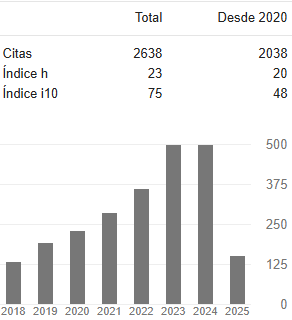Juegos de simulación en la enseñanza de la Ingeniería Industrial: caso de estudio en la Escuela Colombiana de Ingeniería Julio Garavito
DOI:
https://doi.org/10.31908/19098367.3702Palabras clave:
Aprendizaje, diseño, educación universitaria, lego, simulaciónResumen
Las tendencias actuales en la enseñanza de la ingeniería han demostrado la necesidad de un cambio en los modelos pedagógicos tradicionales, por aquellos que promuevan un enfoque hacia el aprendizaje activo en el cual la participación de todos los actores en el proceso es importante. En este sentido, mediante metodologías lúdicas es posible utilizar técnicas y dinámicas propias de los juegos de simulación como medio efi caz para involucrar y motivar a los estudiantes, con el fi n de desarrollar sus habilidades y destrezas, que comúnmente en el aula de clases o en las situaciones de su vida real se ven restringidas por su condición de estudiantes, lo que en ocasiones difi culta la comprensión de problemas que deben enfrentar en la práctica. El presente artículo muestra la metodología usada para la construcción de una lúdica para el desarrollo de habilidades y competencias de estudiantes de ingeniería industrial.
Descargas
Referencias
¨´¨¨Unesco. Engineering: Issues Challenges and Opportunities for Development. 2010.
Yajma, K., Hayakawa, Y., Kashiwaba, Y., Takahshi, A., Oiguchi, S. Construction of Active Learning Environment by the Student Project. Procedia Comput Sci 2016;96:1489–96. doi:10.1016/j.procs.2016.08.195.
Subramanian, A., Timberlake, M., Mittakanti, H., Lara, M., Brandt, M.L. Novel Educational Approach for Medical Students: Improved Retention Rates Using Interactive Medical Software Compared with Traditional Lecture-Based Format. J Surg Educ 2012;69:449–52. doi:10.1016/j.jsurg.2012.05.013.
Littlewood, K.E., Shilling, A.M., Stemland C.J., Wright, E.B., Kirk, M.A. High-fidelity simulation is superior to case-based discussion in teaching the management of shock. Med Teach 2013;35:e1003–10. doi:10.3109/0142159X.2012.733043.
Deterding, S., Khaled, R., Nacke, L., Dixon, D. Gamification: toward a definition. Chi 2011, 2011, p. 12–5. doi:978-1-4503-0268-5/11/0.
Ben-Zvi T, Carton TC. Business Games as Pedagogical Tools. PICMET ’07 - 2007 Portl. Int. Conf. Manag. Eng. Technol., IEEE; 2007, p. 1514–8. doi:10.1109/PICMET.2007.4349473.
Costantino, F., Di Gravio, G., Shaban, A., Tronci, M. A simulation based game approach for teaching operations management topics. Proc. - Winter Simul. Conf., 2012. doi:10.1109/WSC.2012.6465028.
Deterding, S., Dixon, D., Khaled, R., Nacke, L. From game design elements to gamefulness. Proc 15th Int Acad MindTrek Conf Envisioning Futur Media Environ - MindTrek ’11 2011:9–11. doi:10.1145/2181037.2181040.
Hidayatno, A., Indonesia, D., Moeis, A.O. Development of Simulation Game for Teaching Strategic and Operational Aspect of Production System. Proceeding 2014 Int. Conf. Ind. Eng. Oper. Manag., 2014, p. 1316–21.
Bloomer, J., What Have Simulation and Gaming got to do with Programmed Learning and Educational Technology? Innov Educ Train Int 1973;10:224–34. doi:10.1080/1355800730100402.
Adelsberger, H.H., Bick, M.H., Kraus, U.F., Pawlowski, J.M. A simulation Game approach for efficient education in Enterprise Resource Planning systems. Esm’99 - Model Simul A Tool Next Millenn, Vol. 1 1999:Soc Comp Simulat Int; IBIB PAN, Inst Biocybernet &.
Anderson, C. Simulation Game Playing - A Nursing Instructional Strategy. Clin Simul Nurs 2008;4:e7–15. doi:10.1016/j.ecns.2009.05.049.
Bruder, P. Game on: Gamification in the classroom. Educ Dig 2015;80:56.
Agapiou, A. An Evaluation of a Contract Management Simulation Game for Architecture Students. Transactions, 2006;3:38–51. doi:10.11120/tran.2006.03020038.
Silverman, B.G., Holmes, J., Kimmel, S., Branas, C., Ivins, D., Weaver, R., et al. Modeling Emotion and Behavior in Animated Personas to Facilitate Human Behavior Change: The Case of the Heart-sense Game. Health Care Manag Sci 2001;4:213–28. doi:10.1023/A:1011448916375.
Mann, B.D., Eidelson, B.M., Fukuchi, S.G., Nissman, S.A., Robertson, S., Jardines, L. The development of an interactive gamebased tool for learning surgical management algorithms via computer. Am J. Surg 2002;183:305–8. doi:10.1016/S0002-9610(02)00800-0.
Au, T., Parti E.W. Building construction games-general description. J. Constr Div 1969;95:1–9.
Halpin, D.W. Constructo — An Interactive Gaming Environment. J Constr Div 1976;102:145–96.
Veshosky, D., Egbers, J. H. Civil Engineering Project Management Game: Teaching with Simulation. J Prof Issues Eng Educ Pract 1991;117:203–13. doi:10.1061/(ASCE)1052-3928(1991)117:3(203).
Al-jibouri, S.H., Mawdesley, M.J., Scott, D., Gribble, S. The use of a simulation model as a game for teaching management of projects in construction. Int J Eng Educ 2005;21:1195–202.
El-Hajj, A., Kabalan, K.Y. A spreadsheet simulation of logic networks. IEEE Trans Educ 1991;34:43–6. doi:10.1109/13.79879.
Morrow, M. G., Welch, T. B., Wright, C. H. G. An inexpensive software tool for teaching real-time DSP. Proc. 1st IEEE DSP Educ. Work., 2000, p. 15–8.
Drofenik, U., Kolar, J.W. Survey of modern approaches of education in power electronics. IEEE Appl. Power Electron. Conf. Expo., vol. 2, IEEE; 2002, p. 749–55. doi:10.1109/APEC.2002.989329.
Irvine, C.E., Thompson, M. Teaching objectives of a simulation game for computer security. Naval Postgraduate School Monterey Ca 2003.
Navarro, E.O., van der Hoek, A. SIMSE: An Interactive Simulation Game for Software Engineering Education. CATE, In Proceedings of the 7 th IASTED International Conference on Computers and Advanced Technology in Education, Kauai, Hawaii, 2004, p. 12–7.
Leemkuil, H., de Jong, T., de Hoog, R., Christoph, N. KM QUEST: A Collaborative Internet-Based Simulation Game. Simul Gaming 2003;34:89–111. doi:10.1177/1046878102250605.
Benitti, F. B. V., Sommariva, L. Evaluation of a game used to teach usability to undergraduate students in computer science. J Usability Stud 2015;11:21–39.
Connolly, T.M., Stansfield, M., Hainey, T. An application of gamesbased learning within software engineering. Br J Educ Technol 2007;38:416–28.
Benson, T.J. An interactive educational tool for turbojet engines. AIAA, SAE, ASME, ASEE, Jt. Propuls. Conf. Exhib. 31 st, San Diego, CA, 1995.
Benson, T. Interactive educational tool for turbofan and afterburning turbojet engines. 32nd Jt. Propuls. Conf. Exhib., Reston, Virigina: American Institute of Aeronautics and Astronautics; 1996. doi:10.2514/6.1996-2561.
Coller, B.D., Scott, M.J. Effectiveness of using a video game to teach a course in mechanical engineering. Comput Educ 2009;53:900–12. doi:10.1016/j.compedu.2009.05.012.
Bell, J.T., Fogler, H.S. Low-cost virtual reality and its application to chemical engineering-part two. Comput Syst Technol Div Commun 1995;18.
Rovner, S.L. Video game aims to engage students. Chem Eng News 2006;84:15–76.
Carpenter, Y., Moore, E.B., Perkins, K.K. ConfChem Conference on Interactive Visualizations for Chemistry Teaching and Learning: Using an Interactive Simulation To Support Development of Expert Practices for Balancing Chemical Equations. J Chem Educ 2016.
Sterman, J.D. Modeling Managerial Behavior: Misperceptions of Feedback in a Dynamic Decision Making Experiment. Manage Sci 1989;35:321–39. doi:10.1287/mnsc.35.3.321.
Cox, J.F, Walker, E.D. Using a Socratic Game to Introduce Basic Line Design and Planning and Control Concepts. Decis Sci J Innov Educ 2004;2:77–82. doi:10.1111/j.0011-7315.2004.00022.x.
Hidayatno, A., Indonesia, D., Moeis, A. O. Development of Simulation Game for Teaching Strategic and Operational Aspect of Production System. Proc. 2014 Int. Conf. Ind. Eng. Oper. Manag., 2014, p. 1316–21.
Miller, A., Bures, M. New Approach to Industrial Engineering Education with the Help of Interactive Tools. Procedia-Social Behav Sci 2015;174:3413–9.
Müller, B.C., Reise, C., Seliger, G. Gamification in Factory Management Education – A Case Study with Lego Mindstorms. Procedia CIRP 2015;26:121–6. doi:10.1016/j.procir.2014.07.056.
Braghirolli, L.F., Ribeiro, J.L.D., Weise, A.D., Pizzolato, M. Benefits of educational games as an introductory activity in industrial engineering education. Comput Human Behav 2016;58:315–24.
Müller, B.C., Reise, C., Duc, B.M., Seliger, G. Simulation-games for Learning Conducive Workplaces: A Case Study for Manual Assembly.
Procedia CIRP 2016;40:353–8. doi:10.1016/j.procir.2016.01.063.
Mejía, K.A.P., Quevedo, J.L.P., Ramos, A.F.S. Herramienta didáctica para la explicación de conceptos de balanceo de línea en cursos de producción de los programas de ingeniería industrial. Rev Educ En Ing 2016;11:51–8.
Silva, E.D., Macedo, M., Teixeira, C., Lanzer, E., Graziani, Á.P. Game-Based Learning: Analysis of Students’ Motivation, Performance, and Drop Out in a Production Engineering Course. Adv. Hum. Factors, Bus. Manag. Train. Educ., Springer; 2017, p. 933–45.
López, D.C., Mejía, L.A. Aplicación de una lúdica en el salón de clase para enseñanza de la ingeniería industrial . Caso ingeniería de métodos. Entre Cienc E Ing ISSN 1909-8367 Año 8, 15 – Prim Semest 2014, 90 - 99 2014.
Riis, J.O. Simulation games and learning in production management. Springer Science & Business Media; 1995.
Sun, H. A game for the education and training of production/operations management. Educ Train 1998;40:411–6.
Alarcón, L.F., Ashley, D.B. Playing games: Evaluating the impact of lean production strategies on project cost and schedule. Proc. 7th Annu. Conf. Int. Gr. Lean Constr., 1999, p. 263–74.
Adelsberger, H.H., Bick, M.H., Kraus, U.F., Pawlowski, J.M. A simulation game approach for efficient education in enterprise resource planning systems. Proc. ESM, vol. 99, 1999, p. 454–60.
Léger, P.M. Using a simulation game approach to teach enterprise resource planning concepts. J Inf Syst Educ 2006;17:441.
Lee, W.B., Lau, H.C.W., Ning, A. An integrated study methodology for learning strategic inventory management. Int J Eng Educ 2006;22:329.
Chang, Y.C., Chen, W.C., Yang, Y.N., Chao, H.C. A flexible webbased simulation game for production and logistics management courses. Simul Model Pract Theory 2009;17:1241–53. doi:10.1016/j.simpat.2009.04.009.
Pasin, F., Giroux, H. The impact of a simulation game on operations management education. Comput Educ 2011;57:1240–54. doi:10.1016/j.compedu.2010.12.006.
Rodríguez, A., Mejía, K., Ramos, A. Propuesta de un juego de mesa como herramienta didáctica para la explicación de conceptos de control de inventarios en programas de ingeniería industrial. Rev Educ En Ing 2016;11:45–50.
Feng, K., Ma, G. Learning Supply Chain Management with Fun: An Online Simulation Game Approach. Calif J Oper Manag 2008;6:41–8.
Mustafee, N., Katsaliaki, K. The blood supply game. 2010 Winter Simul. Conf., 2010, p. 327–38. doi:10.1109/WSC.2010.5679151.
Anderson, E.G., Morrice, D.J. A simulation game for teaching service-oriented supply chain management: does information sharing help managers with service capacity decisions?*. Prod Oper Manag 2000;9:40–55. doi:10.1111/j.1937-5956.2000.tb00322.x.
Tobail, A., Crowe, J., Arisha, A. Learning by gaming: Supply chain application. Proc. 2011 Winter Simul. Conf., IEEE; 2011, p. 3935–46. doi:10.1109/WSC.2011.6148084.
Manrique, V. Gamification by @victormanriquey: The LevelUP Gamification Design Process n.d. Avalaible: http://www.epicwinblog.net/2014/01/the-levelup-gamification-design-process.html (accessed December 1, 2016).
The Lego Group. LEGO MINDSTORM EV3 User Guide. Lego.com 2013:69. http://www.lego.com/en-gb/mindstorms/downloads/userguide (accessed December 2, 2016).
González, J., Wagenaar, R. Una introducción a Tuning Educational Structures in Europe. La contribución de las universidades al proceso de Bolonia. 2009.
ABET. Criteria For accrediting engineering programs. Engineering accreditation commission 2006.
Hunicke, R., LeBlanc, M., Zubek, R. M. A formal approach to game design and game research. Proc. AAAI Work. Challenges Game AI, vol. 4, 2004, p. 1.
Descargas
Publicado
Número
Sección
Licencia
Derechos de autor 2025 Entre Ciencia e Ingeniería

Esta obra está bajo una licencia internacional Creative Commons Atribución-NoComercial 4.0.



















